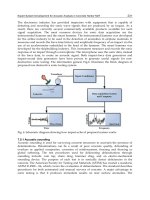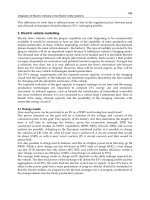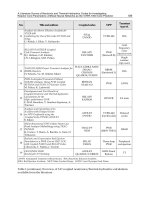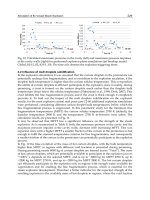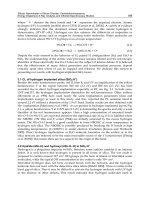NEONATOLOGY: MANAGEMENT, PROCEDURES, ON-CALL PROBLEMS, DISEASES, AND DRUGS - part 9 ppt
Bạn đang xem bản rút gọn của tài liệu. Xem và tải ngay bản đầy đủ của tài liệu tại đây (394.72 KB, 95 trang )
with or without the complication of midgut volvulus.
V. Diagnosis. The exact cause of the obstruction may not be known until a laparotomy is performed.
A. Abdominal x-ray study. In complete duodenal obstruction, the pathognomonic x-ray finding is
a "double bubble." Two large gas collections, one in the stomach and the other in the first portion of
duodenum, are the only lucencies in the GI tract.
B. Radiologic contrast studies
1. Partial obstructions will probably require an upper GI series to identify the site of difficulty.
2. Malrotation. It is important to eliminate malrotation as a possibility because its complication,
midgut volvulus, is a true surgical emergency. This is best done by an upper GI series, identifying a
transverse portion of the duodenum leading to a fixed ligament of Treitz, or by barium enema,
localizing the cecum to its normal, right lower quadrant position.
VI. Management
A. Duodenal atresia or annular pancreas. In cases of atresia or annular pancreas, gastric suction
will control vomiting and allow "elective" surgical correction.
B. Malrotation mandates immediate surgical intervention because the viability of the intestine
from the duodenum to the transverse colon may be at risk from midgut volvulus.
Proximal Intestinal Obstruction
I. Definition. Proximal intestinal obstruction is obstruction of the jejunum.
II. Pathophysiology. Jejunal obstruction typically results from atresia of that segment of the bowel,
usually caused by a vascular accident in utero.
III. Clinical presentation. Infants with jejunal obstruction usually have bilious vomiting associated
with minimal abdominal distention, because few loops of intestine are involved in the obstructive
process.
IV. Diagnosis. A plain abdominal x-ray study reveals only a few dilated small bowel loops with no
gas distally.
V. Management. Surgical correction is required.
Distal Intestinal Obstruction
I. Definition. The term distal intestinal obstruction denotes partial or complete obstruction of the
distal portion of the GI tract. It may be either small bowel (ileum) or large bowel obstruction. The list
of causes includes the following:
A. Ileal atresia.
B. Meconium ileus
1. Uncomplicated (simple) obstruction of the terminal ileum by pellets of inspissated
meconium.
2. Complicated meconium ileus, implying compromise of bowel viability either prenatally or
postnatally.
C. Colonic atresia.
D. Meconium plug-hypoplastic left colon syndrome.
E. Hirschsprung's disease (congenital aganglionic megacolon).
II. Clinical presentation. Infants with obstructing lesions in the distal intestine have similar signs
and symptoms. They typically have distended abdomens, fail to pass meconium, and vomit bilious
material.
III. Diagnosis
A. Abdominal x-ray studies show multiple dilated loops of intestine; the site of obstruction (distal
small bowel vs colon) cannot be determined on plain x-ray films.
B. Contrast radiologic studies. The preferred diagnostic test is contrast enema. It may identify
colonic atresia, outline microcolon (which may signify complete distal small bowel obstruction), or
suggest a transition zone (which may signify Hirschsprung's disease). The procedure can identify and
treat meconium plug-hypoplastic left colon syndrome. If the test is normal, ileal atresia, meconium
ileus, and Hirschsprung's disease are possibilities.
C. Sweat test. A sweat test may be needed to document cystic fibrosis in cases of meconium ileus
(unlikely to be helpful in the first few weeks of life).
D. Mucosal rectal biopsy for histologic detection of ganglion cells is the safest and most widely
available screening test for Hirschsprung's disease. However, laparotomy is often necessary to
determine the exact nature of the problem in infants with normal results of barium enema.
IV. Management
A. Nonoperative management is "curative" in cases of meconium plug and hypoplastic left colon.
1. Passage of time and colonic stimulation by digital examination and rectal enemas
promote return of effective peristalsis.
2. In infants who achieve apparently normal bowel function, one must rule out
Hirschsprung's disease by mucosal rectal biopsy; a small percentage of patients with meconium plug
will prove to have aganglionosis.
3. Interestingly, uncomplicated meconium ileus, if identified, can often be treated by
nonoperative means. Repeated enemas with Hypaque or acetylcysteine (Mucomyst) may disimpact
the inspissated meconium in the terminal ileum and relieve the obstruction.
B. Surgical therapy. Surgical intervention is required for atresia of the ileum or colon, for
complicated meconium ileus, and when the diagnosis is in doubt. Hirschsprung's disease is usually
treated in the neonatal period by colostomy through ganglionic bowel. Some surgeons are performing
"one-stage" pull-through procedures, without preliminary colostomy.
Imperforate Anus
I. Definition. Imperforate anus is the lack of an anal opening of proper location or size. There are two
types: high and low.
A. High imperforate anus. The rectum ends above the puborectalis sling, the main muscle
responsible for maintaining fecal continence. There is never an associated fistula to the perineum. In
males, there may be a rectourinary fistula, and in females, a rectovaginal fistula.
B. Low imperforate anus. The rectum has traversed the puborectalis sling in the correct position.
Variants include anal stenosis, imperforate anus with perineal fistula, and imperforate anus without
fistula.
II. Diagnosis is by inspection and calibration of any perineal opening. All patients with imperforate
anus should have x-ray studies of the lumbosacral spine and urinary tract because there is a high
incidence of dysmorphism in these areas.
III. Management. Surgical therapy in the neonate consists of colostomy for high anomalies and
perineal anoplasty or dilation of fistula for low lesions. If the level is not known, colostomy is
preferable to blind exploration of the perineum. If colostomy is done, a contrast x-ray study of the
distal limb should be performed to ascertain the level at which the rectum ends and to determine the
presence or absence of an associated fistula.
CAUSES OF RESPIRATORY DISTRESS
Choanal Atresia
I. Definition. Choanal atresia is a congenital blockage of the posterior nares caused by persistence of
a bony septum (90%) or a soft tissue membrane (10%).
II. Pathophysiology. Unilateral or bilateral obstruction at the posterior nares may be secondary to
soft tissue or bone. Choanal atresia, which is complete and bilateral, is one of the causes of
respiratory distress immediately after delivery. The effects of upper airway obstruction are
compounded because neonates are obligate nose-breathers and will not "think" to breathe through the
mouth.
III. Clinical presentation. Respiratory distress resulting from partial or total upper airway
obstruction is the mode of presentation.
IV. Diagnosis is based on an inability to pass a catheter into the nasopharynx via either side of
the nose.
V. Management. Simply making the infant cry and thereby breathe through the mouth will
temporarily improve breathing. Insertion of an oral airway will maintain the ability to breathe until
the atresia is surgically corrected.
Pierre Robin Syndrome
I. Definition. This anomaly consists of mandibular hypoplasia in association with cleft palate.
II. Pathophysiology. Airway obstruction is produced by posterior displacement of the tongue
associated with the small size of the mandible.
III. Clinical presentation. Severity of symptoms varies, but most infants manifest a high degree of
partial upper airway obstruction.
IV. Management
A. Infants with mild involvement can be cared for in the prone position and fed through a special
Breck nipple. Adjustment to the airway compromise will occur over days or weeks.
B. More severe cases require nasopharyngeal tubes or surgical procedures to hold the tongue in an
anterior position. Tracheostomy is generally a last resort.
Vascular Ring
Airway compromise is rarely severe and usually presents as stridor.
Laryngotracheal Esophageal Cleft
I. Definition. Laryngotracheal esophageal cleft is a rare congenital anomaly in which there is
incomplete separation of the larynx (and sometimes the trachea) from the esophagus, resulting in a
common channel of esophagus and airway. This communication may be short or may extend almost
the entire length of the trachea.
II. Pathophysiology. The persistent communication between the larynx (and occasionally a
significant portion of the trachea) and the esophagus results in recurring symptoms of aspiration and
respiratory distress with feeding.
III. Clinical presentation. Respiratory distress during feeding is the presenting symptom.
IV. Diagnosis. Contrast swallow may suggest the anomaly, but endoscopy is essential in firmly
establishing the diagnosis and delineating the extent of the defect.
V. Management. Laryngotracheal esophageal cleft is treated by surgical correction, which is difficult
and often unsuccessful.
H-Type Tracheoesophageal Fistula
I. Definition. This anomaly is the third most common type of TEF, making up 5% of cases.
Esophageal continuity is intact, but there is a fistulous communication between the posterior trachea
and the anterior esophagus.
II. Pathophysiology. If the fistula is small, as is usually the case, "silent" aspiration occurs during
feedings with resulting pneumonitis. If the fistula is unusually large, coughing and choking may
accompany each feeding.
III. Clinical presentation. Symptoms, as noted previously, depend on the size of the fistula.
IV. Diagnosis. Barium swallow is the initial diagnostic study and may identify the fistula. The most
accurate procedure, however, is bronchoscopy (perhaps combined with esophagoscopy); this should
allow discovery and perhaps cannulation of the fistula.
V. Management. Surgical correction is required. The approach (via the neck or chest) is determined
by location of the fistula.
Intrinsic Abnormalities of the Airway
I. Definition. Abnormalities of, or within, the airway that cause partial obstruction fall into this
category. Examples include laryngomalacia, paralyzed vocal cord, subglottic web, and hemangioma.
II. Pathophysiology. These lesions result in partial obstruction of the airway and cause stridor and
respiratory distress of varying severity.
III. Clinical presentation. See section II: Pathophysiology.
IV. Diagnosis. The diagnosis is established by endoscopy of the airway.
V. Management is individualized. Some problems, such as laryngomalacia, will be outgrown if the
child can be supported through the period of acute symptoms. Other lesions, such as subglottic webs,
may be amenable to endoscopic resection or laser therapy.
Congenital Lobar Emphysema
I. Definition. Lobar emphysema is a term used to denote hyperexpansion of the air spaces of a
segment or lobe of the lung.
II. Pathophysiology. Inspired air is trapped in an enclosed space. As the cyst of entrapped air
enlarges, the normal lung is increasingly compressed. Cystic problems are more common in the upper
lobes.
III. Clinical presentation. Small cysts may cause few or no symptoms and are readily seen on x-ray
film. Giant cysts may cause significant respiratory distress, with mediastinal shift and compromise of
the contralateral lung.
IV. Diagnosis. Usually, the cysts are easily seen on plain chest x-ray films. However, the radiologic
findings may be confused with those of tension pneumothorax.
V. Management. Therapeutic options include observation for small asymptomatic cysts,
repositioning of the endotracheal tube to selectively ventilate the uninvolved lung for 6-12 h,
bronchoscopy for endobronchial lavage, and operative resection of the cyst with or without the
segment or lobe from which it arises.
Cystic Adenomatoid Malformation
I. Definition. The term cystic adenomatoid malformation encompasses a spectrum of congenital
pulmonary malformation involving varying degrees of adenomatosis and cyst formation.
II. Pathophysiology. Severity of symptoms is related to the amount of lung involved and particularly
to the degree to which the normal ipsilateral and contralateral lung is compressed.
III. Clinical presentation. Signs of respiratory insufficiency such as tachypnea and cyanosis are
modes of presentation.
IV. Diagnosis. The characteristic pattern on chest x-ray film is multiple discrete air bubbles,
occasionally with air-fluid levels, involving a region of the lung. The radiographic appearance can
mimic that of congenital diaphragmatic hernia (CDH).
V. Management. Treatment is surgical resection of the involved lung, allowing reexpansion of
compressed normal pulmonary tissue.
Congenital Diaphragmatic Hernia
I. Definition. A patent pleuroperitoneal canal through the foramen of Bochdalek is the essential
defect in CDH.
II. Pathophysiology
A. Prenatal. The abnormal communication between the peritoneal and pleural cavities allows
herniation of intestine into the pleural space as the developing GI tract returns from its extracoelomic
phase at 10-12 weeks' gestation. Depending on the degree of pulmonary compression by herniated
intestine, there may be marked diminution of bronchial branching, limited multiplication of alveoli,
and persistence of muscular hypertrophy in pulmonary arterioles. These anatomic abnormalities are
most notable on the side of the CDH (usually the left); they are also present to some degree in the
contralateral lung.
B. Postnatal. After delivery, the anatomic anomaly may contribute to the development of either or
both of the following pathologic conditions:
1. Pulmonary parenchymal insufficiency. Infants with CDH have an abnormally small
functional lung mass. Some have so few conducting air passages and developed alveolia condition
known as pulmonary parenchymal insufficiencythat survival is unlikely.
2. Pulmonary hypertension. Infants with CDH are predisposed anatomically to pulmonary
hypertension of the newborn (PHN), also known as persistent fetal circulation (PFC). In this
condition, blood is shunted around the lungs through the foramen ovale and patent ductus arteriosus.
Shunting promotes acidosis and hypoxia, both of which are potent stimuli to additional pulmonary
vasoconstriction. Thus, a vicious cycle of clinical deterioration is established.
III. Clinical presentation. Most infants with CDH exhibit significant respiratory distress within the
first few hours of life.
IV. Diagnosis. Prenatal diagnosis can reliably be made by ultrasonography. Delivery should occur in
a neonatal center with extracorporeal membrane oxygenation (ECMO) capability. Afflicted infants
tend to have scaphoid abdomens because there is a paucity of the GI tract located in the abdomen.
Auscultation reveals diminished breath sounds on the affected side. Diagnosis is established by a
chest x-ray film that reveals a bowel gas pattern in one hemithorax, with shift of mediastinal
structures to the other side and compromise of the contralateral lung.
V. Management
A. Indwelling arterial catheter. Blood gas levels should be monitored by an indwelling arterial
catheter.
B. Supportive care. Appropriate respiratory and metabolic support should be provided. CDH
lungs are surfactant deficient, and replacement therapy appears to be helpful. Avoidance of
aggressive conventional hyperventilation, permissive hypercapnia, seems to improve survival and
decrease complications.
C. Nasogastric intubation should be performed to lessen gaseous distention of the stomach and
intestine. For the same reason, any positive-pressure ventilation must be delivered by endotracheal
tube, never by mask.
D. Surgical correction is by reduction of intrathoracic intestine and closure of the diaphragmatic
defect. Surgical intervention is obviously an essential element of treatment, but it is not the key to
survival. Formerly, surgery was performed on an urgent or emergent basis. Current thinking favors a
delayed approach, allowing the newborn to stabilize a hyperreactive pulmonary vascular bed and to
improve pulmonary compliance. If indicated, ECMO can be instituted and repair performed while on
support 1 or 2 days after decannulation.
E. ECMO is used in the treatment of neonates with severe respiratory failure. Exposure of venous
blood to the extracorporeal circuit allows correction of PO
2
and PCO
2
abnormalities as well as
recovery of the lungs from the trauma associated with positive-pressure ventilation (see
Chapter 11).
VI. Prognosis. Mortality rates for infants with CDH are still in the range of 50%. This high rate has
prompted a search for other modes of treatment in addition to the expensive, labor-intensive modality
ECMO.
A. Fetal surgery has been performed successfully on a limited basis, with the idea that in utero
intervention will lessen the risk for development of pulmonary hypoplasia, which may be
incompatible with life after delivery. Formal operative correction of CDH in the fetus has been
abandoned, but several centers currently perform in utero tracheal occlusion in selected patients. This
appears to result in increased lung fluid and to promote pulmonary growth.
B. Medications. Another major area of research is the attempt to develop a pharmacologic agent to
selectively decrease pulmonary vascular resistance. Such an agent would help solve the problem of
PHN (PFC).
ABDOMINAL MASSES
Renal Masses
In most clinical series, the majority of abdominal masses in neonates are renal in origin. They may be
unilateral or bilateral, solid or cystic. After physical examination, evaluation begins with
ultrasonography, which is simple and safe to perform. Ultrasonography should define the solid or
cystic nature of the mass, determine the presence or absence of normal kidneys, and yield information
on other intra-abdominal abnormalities. In selected instances, more involved procedures such as renal
scan, computed tomography (CT) scan, retrograde pyelography, venography, and arteriography may
be needed to define the problem and plan appropriate therapy.
I. Multicystic kidney is a form of renal dysplasia and the most common renal cystic disease of the
newborn. Fortunately, it is usually unilateral. Ultrasonography can define the nature of the disorder,
and CT/nuclear renal scans are useful in assessing the remainder of the urinary system. Nephrectomy
is appropriate treatment.
II. Hydronephrosis. Urinary obstruction, depending on its location, can cause unilateral or bilateral
flank and abdominal masses. Treatment is by correction of the obstructing lesion or decompression
proximal to it. A kidney rendered nonfunctional by back pressure is usually best removed.
Obstructive uropathy may be one category of lesion suitable for in utero intervention. Surgery on the
developing fetus to decompress the obstructed urinary system may improve the postnatal status and
increase survival.
III. Infantile polycystic kidney disease. Inherited in an autosomal recessive fashion, this entity
involves both kidneys and carries a grim prognosis.
IV. Renal vein thrombosis. The typical presentation is one or more flank masses and hematuria,
usually within the first 3 days of life. Risk factors are maternal diabetes and dehydration. In general,
conservative nonoperative management is recommended.
V. Wilms' tumor. See p 580.
Ovarian Masses
Simple ovarian cyst has been called the most frequently palpated abdominal mass in the female
neonate. It presents as a relatively mobile, smooth-walled abdominal mass. It is not associated with
cancer, and excision with preservation of any ovarian tissue is curative.
Hepatic Masses
The liver can be enlarged, often to grotesque proportions, by a variety of problems. When physical
examination, ultrasonography, and other x-ray studies suggest hepatic origin, CT or angiography
should be performed. These studies may be diagnostic and will aid in surgical planning. Lesions
include the following:
I. Hepatic cysts.
II. Solid, benign tumors.
III. Vascular tumors
A. Hemangiomas of the liver may cause heart failure, thrombocytopenia, and anemia. Therapeutic
options include digitalis, corticosteroid administration, embolization, hepatic artery ligation, and liver
resection.
B. Hemangioendothelioma.
IV. Malignant tumors. Hepatoblastoma is by far the most common liver cancer in the neonate.
Serum alpha-fetoprotein may be elevated. Although surgical resection remains the key to achieving
cure, new chemotherapeutic protocols (cisplatin [Platinol] and doxorubicin [Adriamycin]) may
significantly improve the formerly dismal prognosis for infants with this tumor.
Gastrointestinal Masses
Palpable abdominal masses that arise from the GI tract are unusual and tend to be cystic, smooth
walled, and mobile (depending on the size). Causes include intestinal duplication and mesenteric cyst.
RETROPERITONEAL TUMORS
Neuroblastoma
I. Definition. Neuroblastoma is a primitive malignant neoplasm that arises from neural crest tissue. It
is probably the most common congenital tumor and is usually located in the adrenal gland.
II. Clinical presentation. This tumor typically presents as a firm, fixed, irregular mass extending
obliquely from the costal margin, occasionally across the midline and into the lower abdomen.
III. Diagnosis
A. Laboratory studies. A 24-h urine collection should be analyzed for vanillylmandelic acid and
other metabolites.
B. Radiologic studies. A plain abdominal x-ray film may reveal calcification within the tumor.
Intravenous pyelogram (IVP) and CT scan typically show extrinsic compression and inferolateral
displacement of the kidney. Search for possible metastatic deposits involves bone marrow aspiration
and biopsy, bone scan, chest x-ray study, and chest CT scan.
IV. Management. Planned therapy should take into account the well-recognized but poorly
understood fact that neuroblastoma is notably less aggressive in the young infant than in the older
child.
Wilms' Tumor (Nephroblastoma)
I. Definition. Wilms' tumor is an embryonal renal neoplasm in which blastemic, stromal, and
epithelial cell types are present. Renal involvement is usually unilateral but may be bilateral (5% of
cases).
II. Clinical presentation. A palpable abdominal mass extending from beneath the costal margin is
the usual mode of presentation.
III. Risk factors include aniridia, hemihypertrophy, certain genitourinary anomalies, and a family
history of nephroblastoma.
IV. Diagnosis
A. Laboratory studies. There is no tumor marker for Wilms' tumor.
B. Radiologic studies. Ultrasonography is generally followed by CT scan, which reveals intrinsic
distortion of the caliceal system of the involved kidney. The possibility of tumor thrombus in the
renal vein and inferior vena cava should be evaluated by ultrasonography and venography, if
necessary.
V. Management
A. Unilateral renal involvement. Nephrectomy is the first step in treatment. Surgical staging
determines the administration of radiotherapy and chemotherapy; both are very effective.
B. Bilateral renal involvement. Treatment of bilateral Wilms' tumor is highly individualized.
Teratoma
I. Definition. Teratoma is a neoplasm containing elements derived from all three germ cell layers:
endoderm, mesoderm, and ectoderm. Teratomas in the neonate are primarily sacrococcygeal in
location and are believed to represent a type of abortive caudal twinning.
II. Clinical presentation. This tumor is usually grossly evident as a large external mass in the
sacrococcygeal area. Occasionally, however, it may be presacral and retroperitoneal in location and
may present as an abdominal mass.
III. Diagnosis. See section II: Clinical Presentation. Digital rectal examination of the presacral space
is important.
IV. Management. Because the incidence of malignancy in these tumors increases with age, prompt
surgical excision is required.
ABDOMINAL WALL DEFECTS
Gastroschisis
I. Definition. Gastroschisis is a centrally located, full-thickness abdominal wall defect with two
distinctive anatomic features.
A. The extruded intestine never has a protective sac covering it.
B. The umbilical cord is an intact structure at the level of the abdominal skin, just to the left of
the defect. Typically, the opening in the abdominal wall is 2- 4 cm in diameter, and the solid organs
(the liver and spleen) reside in the peritoneal cavity.
II. Pathophysiology. Exposure of unprotected intestine to irritating amniotic fluid in utero results in
its edematous, indurated, foreshortened appearance. Because of these intestinal abnormalities,
development of appropriate peristalsis and effective absorption is significantly delayed, usually by
several weeks. Fortunately, associated congenital anomalies are rare in patients with gastroschisis.
III. Clinical presentation. See sections I, Definition, and II, Pathophysiology.
IV. Diagnosis. The key differential diagnosis is ruptured omphalocele, although the diagnosis is
readily apparent in most cases. Increasingly, prenatal ultrasonography identifies gastroschisis.
V. Management
A. General considerations. All agree that infants with gastroschisis should be delivered at a
neonatal center equipped and staffed to provide definitive care. Less certain is the recommended
mode of delivery. Some experts argue that abdominal wall defect is an indication for cesarean
section. However, other investigators note that, in the absence of other factors, vaginal delivery does
not increase the mortality, morbidity, or length of hospital stay for newborns with gastroschisis.
B. Specific measures
1. Temperature regulation. Immediate attention should be directed toward maintenance of
normal body temperature. The tremendous intestinal surface area exposed to the environment puts
these infants at great risk for hypothermia.
2. Protective covering. It is best not to keep replacing moist, saline-soaked gauze over the
exposed intestine because doing so promotes evaporative heat loss. It is better to apply a dry (or
moist) protective dressing and then wrap the abdomen in layers of cellophane. A warm, controlled
environment should be provided.
3. Nasogastric decompression is helpful.
4. Broad-spectrum antibiotic coverage is appropriate, given the unavoidable contamination.
5. Total parenteral nutrition. A protracted ileus is to be expected, and appropriate intravenous
nutritional support must be provided.
6. Surgical correction. As soon as the infant's condition permits, operative correction should be
undertaken. Complete reduction of herniated intestine, with primary closure of the abdominal wall, or
placement of unreduced intestine in a protective prosthetic silo, with subsequent staged reduction
over 7-14 days, is usually performed.
Omphalocele
I. Definition. An omphalocele is a herniation of abdominal contents into the base of the umbilical
cord. The gross appearance of omphalocele differs from that of gastroschisis in two important
respects.
A. A protective membrane encloses the malpositioned abdominal contents (unless rupture has
occurred, eg, during the birth process).
B. Elements of the umbilical cord course individually over the sac and come together at its
apex to form a normal-appearing umbilical cord.
II. Associated anomalies. Significant associated congenital anomalies occur in ~25-40% of infants
with omphalocele. Problems include chromosomal abnormalities, CDH, and a variety of cardiac
defects.
III. Clinical presentation. There are different sizes of omphaloceles. The smaller ones typically
contain only intestine; large or giant omphaloceles contain liver and spleen as well as the GI tract.
The peritoneal cavity in infants with large or giant omphaloceles is very small because growth has
proceeded without the solid organs in proper position.
IV. Diagnosis. The anomaly is usually apparent. Ruptured omphalocele may be confused with
gastroschisis; both defects are characterized by exposed intestine, but infants with omphalocele do
not possess an intact umbilical cord at the level of the abdominal wall to the left of the defect. Careful
studies to identify associated congenital anomalies should be performed.
V. Management. Reduction, even in stages over a lengthy period, may be very difficult to achieve.
Therapeutically, infants with omphalocele fall into two main groups.
A. Ruptured sac. Infants with ruptured sacs resemble those with gastroschisis. The unprotected
intestine should be cared for as described for gastroschisis (see Abdominal Wall Defects,
Gastroschisis, section V,B,2, p 581), and the problem should be corrected surgically on an emergent
basis.
B. Intact sac. Intact omphalocele is a less urgent surgical problem. The protective membrane
conserves heat and in most cases allows effective peristalsis. This sac should be carefully protected.
Some surgeons favor daily dressing changes with gauze pads impregnated with povidone-iodine until
the sac toughens and desiccates. The timing of surgery is influenced by a number of factors,
including the dimensions of the defect, size of the infant, and presence of other anomalies.
Nonoperative staged reduction using compressive dressings has been described.
Exstrophy of the Bladder
I. Definition. Exstrophy of the bladder is a congenital malformation of the lower anterior abdominal
wall. In this defect, the internal surface of the posterior wall of the urinary bladder extrudes through
the abdominal wall defect. The problem occurs in varying degrees of severity, ranging from
epispadias to complete extroversion of the bladder, with exposure of the ureteral orifices.
II. Clinical presentation. The lower abdominal wall defect is obvious; exposed bladder mucosa is
markedly edematous and friable.
III. Diagnosis. Diagnosis is by inspection. Radiologic evaluation of the proximal urinary tract is
advisable.
IV. Management
A. Protective covering. The bladder should be carefully protected with Vaseline gauze or
cellophane wrap. Attention should also be paid to protection of the surrounding skin.
B. Surgical repair. In most centers, primary closure of the bladder is attempted within the first 48-
72 h of life, while the sacroiliac joints are still pliable and the pelvis can be "molded" to allow better
approximation of the pubic rami.
Cloacal Exstrophy
I. Definition. Cloacal exstrophy is a rare but devastating complex of anomalies, including
imperforate anus, exstrophy of the bladder, omphalocele, and vesicointestinal fistula, frequently with
prolapse of bowel through the fistula onto the bladder mucosa.
II. Clinical presentation. See section I: Definition.
III. Diagnosis. Diagnosis is by inspection. Evaluation of the genitourinary system and GI tract is
appropriate.
IV. Management
A. Protective covering. Exposed mucosa, both bladder and intestine, should be protected with
Vaseline gauze or cellophane wrap. Ointments should be applied to the surrounding skin to prevent
maceration.
B. Surgical care. Prompt surgery to separate the fecal and urinary streams is imperative.
MISCELLANEOUS SURGICAL CONDITIONS
Necrotizing Enterocolitis
In most centers, necrotizing enterocolitis (NEC) is the most common indication for operation in
neonates (see also Chapter 71). Abdominal exploration is usually reserved for infants with full-
thickness necrosis of the intestine, usually manifested by pneumoperitoneum (best identified by serial
left lateral decubitus x-ray films). Other, less common indications for surgery include cellulitis and
induration of the abdominal wall and an unchanging abdominal mass. Delayed stricture formation,
which is most common on the left side of the colon, complicates NEC in 15-25% of cases.
Hypospadias
I. Definition. Hypospadias is a developmental anomaly in which the external opening of the urethra
is present on the underside of the penis or on the perineum rather than in its normal position at the
end of the penile shaft.
II. Clinical presentation. There are different anatomic classifications, depending on the location of
the meatal opening and the degree of chordee (curvature of the penis). There is a high incidence of
associated cryptorchidism in these patients. Severe cases of hypospadias may be confused with
ambiguous genitalia.
III. Diagnosis. The anomaly is readily apparent (see sections I, Definition, and II, Clinical
Presentation). Radiologic evaluation of the urinary system is appropriate to screen for other
anomalies.
IV. Management. Surgical correction usually should not be attempted in the newborn. Because
foreskin tissue may be needed for later surgical correction, circumcision must be avoided in infants
with hypospadias.
Inguinal Hernia and Hydrocele
I. Definition. Persistence of a patent processus vaginalis (related to testicular descent) is responsible
for inguinal hernia and hydrocele in the neonate.
A. Inguinal hernia. The opening of the patent processus at the internal ring is large enough to
allow a loop of intestine to extrude from the abdominal cavity with an increase in intra-abdominal
pressure.
B. Hydrocele. The patent processus is too narrow to permit egress of intestine; peritoneal fluid
drips down along the course of the narrow patent processus and accumulates in the scrotum.
II. Diagnosis
A. Inguinal hernias tend to present as lumps or bulges that come and go at the pubic tubercle.
Less commonly, they descend into the scrotum.
B. Hydroceles typically are scrotal in location, transilluminate, and are not reducible.
III. Management
A. Inguinal hernia carries a 5-15% risk of incarceration during the first year of life. Accordingly,
they are usually surgically repaired when the infant's general medical condition permits.
B. Hydrocele frequently resolves without specific treatment because the obliteration of the narrow
patent processus continues after birth. Persistence of hydrocele beyond 6-12 months is an indication
for surgical repair.
Umbilical Hernia
I. Definition. This hernia is a skin-covered fascial defect at the umbilicus that allows protrusion of
intra-abdominal content.
II. Diagnosis. Transmission of intra-abdominal pressure via fascial defect at the umbilicus
establishes the diagnosis.
III. Management. In infancy, surgical intervention for an umbilical hernia is seldom warranted.
Complications such as incarceration and skin breakdown are exceedingly rare. The natural history is
one of gradual closure of the umbilical fascial defect, often leading to complete resolution of the
problem.
Undescended Testicles (Cryptorchidism)
Undescended testicles occur in ~33% of premature and 3% of term male infants. Many undescended
testes will descend in the first few months after birth. Unless there is an associated inguinal hernia,
surgical correction is usually not performed until the infant is between 1 and 2 years of age, although
some surgeons favor earlier correction.
Posterior Urethral Valves
I. Definition. Posterior urethral valves are abnormal valves in the urethra at the verumontanum. They
represent the most common cause of congenital obstructive uropathy in males.
II. Pathophysiology. The high degree of bladder outlet obstruction caused by posterior urethral
valves results in proximal dilatation. The urinary bladder enlarges, the ureters become dilated and
tortuous, and back pressure in the collecting systems compromises developing renal parenchyma.
III. Clinical presentation
A. Prenatal ultrasonography currently identifies many infants with posterior urethral valves.
B. After birth, neonates with this anomaly have bilateral flank masses, a distended bladder, and
poor urinary stream (with dribbling).
IV. Diagnosis. Voiding cystourethrography documents the abnormal valves.
V. Management. The goal of therapy is preservation of renal function and avoidance of renal failure.
A. Renal function and the infant's general status should be evaluated.
B. Stabilization, rehydration, correction of electrolyte abnormalities, and treatment of urinary
tract infection should be accompanied by transurethral drainage of the bladder, using a No. 5 French
infant feeding tube.
C. Surgical therapy
1. Ablation of valves is the initial operative procedure favored by most pediatric urologists.
2. Urinary diversion may be indicated.
REFERENCES
Albanese CT (ed): Abdominal masses in the newborn. Semin Pediatr Surg 2000;9:107.
Bianchi A: One stage neonatal reconstruction without stoma for Hirschsprung's disease. Semin
Pediatr Surg 1998;7:170.
Chwals WJ et al: Surgery-associated complications in necrotizing enterocolitis: a multi- institutional
study.
J Pediatr Surg 2001;36:1722.
Dimmitt RA et al: Venoarterial versus venovenous extracorporeal membrane oxygenation in
congenital diaphragmatic hernia: the extracorporeal life support organization registry, 1990- 1999.
J
Pediatr Surg 2001;36:1199.
Greenholz SK: Congenital diaphragmatic hernia: an overview.
Semin Pediatr Surg 1996;5:216.
Langer JC: Gastroschisis and omphalocele.
Semin Pediatr Surg 1996;5:124.
Moss RL et al: A meta-analysis of peritoneal drainage versus laparotomy for perforated necrotizing
enterocolitis.
J Pediatr Surg 2001;36:1210.
Nuchtern JG, Harberg FJ: Congenital lung cysts.
Semin Pediatr Surg 1994;3:233.
O'Neill JA et al (eds): Pediatric Surgery, 5th ed. Mosby-Year Book, 1998.
Pena A: Imperforate anus and other hindgut malformations. Semin Pediatr Surg 1997;6:165.
Wong JT et al: Congenital diaphragmatic hernia: survival treated with very delayed surgery,
spontaneous respiration and no chest tube.
J Pediatr Surg 1995;30:406.
CHAPTER 79. Thyroid Disorders
INTRODUCTION
Disorders of thyroid function in infants often present a diagnostic dilemma. Signs of thyroid
dysfunction are rarely present at birth, and initial signs and symptoms are often subtle or misleading.
A good understanding of the unique thyroid physiology and the assessment of thyroid function in
neonates is necessary in order to recognize, diagnose, and treat thyroid disorders.
GENERAL CONSIDERATIONS
I. Fetal and neonatal thyroid function
A. Embryogenesis begins during the third week of gestation and continues through 10-12 weeks'
gestation. At that time, thyroid-stimulating hormone (TSH) can be detected. Thyroid activity remains
low until midgestation and then increases slowly until term.
B. Thyroid hormones undergo rapid and dramatic changes in the immediate postnatal period.
1. An acute release of TSH occurs within minutes after birth. Peak values of 60-80 uU/mL
are seen at 30-90 min. Levels decrease to <5 uU/mL by 3-5 days.
2. Stimulated by the TSH surge, thyroxine (T
4
), free T
4
(FT
4
), and triiodothyronine (T
3
)
rapidly increase, reaching peak levels by 24 h. Levels decrease slowly over the first few weeks of life.
C. Thyroid function in the premature infant. Identical changes in TSH, T
4
, and T
3
are seen in
premature infants; however, absolute values are lower. TSH levels return to normal by 3-5 days of
life regardless of gestational age.
II. Physiologic action of thyroid hormones. Thyroid hormones have profound effects on growth
and neurologic development. They also influence O
2
consumption, thermogenesis, and the metabolic
rate of many processes.
III. Biochemical steps to thyroid hormone synthesis. Thyroid hormone production includes the
stages of iodide transport, thyroglobulin synthesis, organization of iodide, monoiodotyrosine and
diiodotyrosine coupling, thyroglobulin endocytosis, proteolysis, and deiodination.
IV. Assessment of thyroid function. Thyroid tests are intended to measure the level of thyroid
activity and to identify the cause of thyroid dysfunction.
A. T
4
concentration is the most important parameter in the evaluation of thyroid function. More
than 99% of T
4
is bound to thyroid hormone-binding proteins. Therefore, changes in these proteins
may affect T
4
levels. Serum levels for term newborn infants range between 7.3 and 22.9 mcg/dL.
B. Free T
4
reflects the availability of thyroid hormone to the tissues. Serum levels vary widely by
gestational age: newborn term infants, 2.0-5.3 ng/dL; preterm infants of 31-36 weeks' gestation, 1.3-
4.7 ng/dL; and infants of 25-30 weeks' gestation, 0.6-3.3 ng/dL.
C. TSH measurement is one of the most valuable tests in evaluating thyroid disorders,
particularly primary hyperthyroidism. Serum levels over all gestational ages of 25-42 weeks range
from 2.5 to 18.0 uU/mL.
D. T
3
concentration is particularly useful in the diagnosis and treatment of hyperthyroidism.
Serum levels of T
3
are very low in the fetus and cord blood samples (20-75 ng/dL). Shortly after
birth, levels exceed 100 ng/dL, up to 260 ng/dL. In hyperthyroid states, levels may exceed 400 ng/dL.
In sick preterm infants, a very low T
3
(hypothyroid range) may signal the euthyroid sick syndrome,
also known as the nonthyroidal illness syndrome.
E. Thyroid-binding globulin (TBG) can be measured directly by radioimmunoassay. T
3
resin
uptake provides an indirect measurement of TBG and is now considered an outdated test, unless it is
factored with the T
4
level to give an FT
4
index, using the infant's T
4
level and T
3
uptake against a
normal control T
3
uptake. TBG may be decreased in preterm infants, in those with malnutrition, and
in those with chronic illness. It is increased by estrogens and heroin. Drugs such as Dilantin
(phenytoin), diazepam, heparin, and furosemide compete with T
4
for TBG binding sites, resulting in
falsely low T
4
levels.
F. The thyrotropin-releasing hormone (TRH) stimulation test can assess pituitary and thyroid
responsiveness. It is used to differentiate between secondary and tertiary hypothyroidism.
G. Thyroid imaging
1. Thyroid scanning with iodine 123 or technetium Tc 99m pertechnetate is used to identify
functional thyroid tissue. Iodine 123 is the preferable isotope for children.
2. Ultrasonography is useful in evaluating anatomy but is not a reliable alternative to a scan.
CONGENITAL HYPOTHYROIDISM
I. Definition. Congenital hypothyroidism is defined as a significant decrease in, or the absence of,
thyroid function present at birth.
II. Incidence. The overall incidence is 1 in 3500 to 1 in 4500 births. Sporadic cases account for 85%
of patients diagnosed; 15% are hereditary. It is more prevalent among females than males by a ratio
of 2:1. It is more common in Hispanic and Asian infants (1 in 3000 births) and less common in blacks
(1 in 32,000 births). The incidence is significantly increased in Down syndrome (1 in 140).
III. Etiologic classification
A. Primary hypothyroidism
1. Developmental defects such as ectopic thyroid (most common), thyroid hypoplasia, or
agenesis.
2. Inborn errors of thyroid hormone synthesis.
3. Maternal exposure to radioiodine, propylthiouracil, or methimazole during pregnancy.
4. Iodine deficiency (endemic cretinism).
B. Secondary hypothyroidism: TSH deficiency.
C. Tertiary hypothyroidism: TRH deficiency.
D. Hypopituitary hypothyroidism: associated with other hormonal deficiencies.
IV. Molecular pathogenesis. Autosomal recessive inheritance of mutations of thyroid peroxidase,
thyroglobulin, NIS (sodium iodide symporter) and pendrin genes, all encoding for sodium iodide
transporters, have been identified in patients with congenital hypothyroidism. The autosomal
recessively inherited thyroid-stimulating receptor gene has been identified in patients with congenital
hypothyroidism and thyroid hypoplasia, as have autosomal dominant mutations of the PAX-8 gene
and genes coding for other transcription factors in thyroid dysgenesis.
V. Clinical presentation. Symptoms are usually absent at birth; however, subtle signs may be
detected during the first few weeks of life.
A. Early manifestations. Signs at birth include prolonged gestation, large size for gestational age,
large fontanelles, and respiratory distress syndrome. Manifestations that may be seen by 2 weeks
include hypotonia, lethargy, hypothermia, prolonged jaundice, and feeding difficulty.
B. Late manifestation. Classic features usually appear after 6 weeks and include puffy eyelids,
coarse hair, large tongue, myxedema, and hoarse cry. Late manifestations in borderline
hypothyroidism detected in screening programs can present as significant hearing impairment with
speech delays.
VI. Diagnosis
A. Screening. Newborn screening for congenital hypothyroidism is mandatory in most states.
1. Method. Most programs use a twofold process with the filter paper spot technique. A T
4
measurement is followed by a measurement of TSH in specimens with low T
4
values (T
4
in the 10th
percentile).
2. Timing. The ideal time for screening is between days 2 and 6 of life. Infants discharged
before 48 h should be screened before discharge; however, this increases the number of false-positive
results because of the TSH surge that occurs at birth. A repeat test at 2 to 6 weeks identifies about
10% of cases.
3. Results. A low T
4
level (<7 mcg/dL) and TSH concentrations >40 uU/mL are indicative of
congenital hypothyroidism. Borderline TSH levels (20-40 uU/mL) should be repeated.
B. Diagnostic studies
1. Serum for confirmatory measurements of T
4
and TSH concentrations should be tested. If an
abnormality of TBG is suspected, FT
4
and TBG concentrations should also be evaluated.
2. Thyroid scan remains the most accurate diagnostic modality to determine the cause of
congenital hypothyroidism.
VII. Management
A. Consultation with a pediatric endocrinologist is recommended.
B. Treatment. Sodium L-thyroxine is the drug of choice because of its uniform potency and
reliable absorption. The average starting dose is 10-15 mcg/kg/ day. Usually, term infants receive a
50-ug tablet daily; preterm infants, 25 mcg daily. The goal of therapy is to maintain T
4
concentration
in the upper normal range (10-16 mcg/dL) and TSH <10 uU/mL.
C. Follow-up. Frequent T
4
and TSH measurements are required to ensure optimal treatment.
Recommended follow-up is as follows:
1. At 2 and 4 weeks after initiation of therapy.
2. Every 1-2 months for the first year.
3. Two weeks after changing dosage.
VIII. Prognosis. Prognosis is dependent on prudent initiation of therapy and subsequent management
in an effort to mitigate the deficits in neurocognitive areas.
NEONATAL THYROTOXICOSIS
I. Definition. Neonatal thyrotoxicosis is defined as a hypermetabolic state resulting from excessive
thyroid hormone activity in the newborn.
II. Causes
1. This disorder usually results from transplacental passage of thyroid-stimulating
immunoglobulin from a mother with Graves' disease.
2. Congenital non-autoimmune hyperthyroidism has been identified, resulting from activating
mutations in the thyrotropin receptor as well as stimulatory G protein.
III. Incidence. This is a rare disorder occurring in only ~1 of 70 thyrotoxic pregnancies (autoimmune
disease). (The incidence of maternal thyrotoxicosis in pregnancy is 1-2 per 1000 pregnancies.)
IV. Clinical presentation. Fetal tachycardia in the third trimester may be the first manifestation.
Signs are usually apparent within hours after birth unless the mother was taking antithyroid
medications, in which case the presentation may be delayed 2-10 days. Thyrotoxic signs include
irritability, tachycardia, flushing, tremor, poor weight gain, thrombocytopenia, and arrhythmias. A
goiter is usually present and may be large enough to cause tracheal compression.
V. Diagnosis
A. History and physical examination. A maternal history of Graves' disease and the presence of a
goiter are most consistent with thyrotoxicosis.
B. Laboratory studies. Diagnosis is confirmed by demonstrating increased levels of T
4
, FT
4
, and
T
3
with suppressed levels of TSH.
VI. Management. Although the disorder is usually self-limited, therapy depends on the severity of
the symptoms.
A. Mild. Close observation is required. Therapy is not necessary.
B. Moderate. Administer one of the following antithyroid medications:
1. Lugol's solution (iodine), 1 drop every 8 h.
2. Propylthiouracil, 5-10 mg/kg/day in 3 divided doses.
3. Methimazole, 0.5-1 mg/kg/day in 3 divided doses.
C. Severe. In addition to the medications just listed, during extreme conditions, prednisone, 2 mg/
kg/day; propranolol, 1-2 mg/kg/day in 2-4 divided doses; and digitalis (in preventing cardiovascular
collapse) may be used.
D. Non-autoimmune hyperthyroidism requires thyroid gland ablation or near-total
thyroidectomy.
VII. Prognosis. The disorder is usually self-limited and disappears spontaneously within 2-4 months.
Mortality in affected infants is ~15% if the disorder is not recognized and treated properly.
TRANSIENT DISORDERS OF THYROID FUNCTION IN THE NEWBORN
I. Euthyroid sick syndrome
A. Definition. Transient alteration in thyroid function associated with severe nonthyroidal illness.
B. Incidence. The syndrome is frequently seen in premature infants because of their increased
susceptibility to neonatal morbidity. Preterm infants with respiratory distress syndrome have been the
most frequently reported patients with this disorder.
C. Diagnosis. A low T
3
level is usually present, associated with low or normal T
4
and normal
TSH. Infants are euthyroid (normal TSH).
D. Treatment. Treatment has not been shown to be beneficial. Abnormal thyroid functions return
to normal as the sick infant improves.
II. Transient hypothyroxinemia
A. Incidence. All preterm infants have some degree of hypothyroxinemia (>50% have T
4
levels
<6.5 mcg/dL).
B. Pathophysiology. The condition is presumed to be related to immaturity of the hypothalamic-
pituitary axis.
C. Diagnosis is low T
4
and FT
4
with normal TSH and normal response to the TRH stimulation test.
D. Treatment. No treatment is required. This disorder corrects spontaneously with progressive
maturation, usually in 4-8 weeks. Attempts to supplement preterm infants born before 30 weeks'
gestation with thyroxine to improve neurologic outcome have been unsuccessful.
REFERENCES
Adams L et al: Reference ranges for newer thyroid function tests in pre-mature infants.
J Pediatr
1995;126:122.
American Academy of Pediatrics, Section on Endocrinology and Committee on Genetics, American
Thyroid Association, Committee on Public Health: Newborn screening for congenital
hypothyroidism: recommended guidelines. Pediatrics 1993;9:1203.
Biswas S et al: Thyroid function in very preterm infants. Pediatrics 2002;2:222.
Fisher DA: Thyroid function in premature infants. The hypothyroxinemia of prematurity.
Clin
Perinatol 1998;25:999.
Hunter MK et al: Follow-up of newborns with low thyroxine and nonelevated thyroid-stimulating
hormone-screening concentrations: results of the 20-year experience in the Northwest Regional
Newborn Screening Program.
J Pediatr 1998;132:70.
Krude H et al: Molecular pathogenesis of neonatal hypothyroidism.
Horm Res 2000;53(suppl 1):12.
LaFranchi S: Congenital hypothyroidism: etiologies, diagnosis, and management
Thyroid 1999;
9:735.
Osborn DA: Thyroid hormone for preventing of neurodevelopmental impairment in preterm infants.
Cochrane Database Syst Rev 2001;4:CD001070.
Polk DH, Fisher DA: Fetal and neonatal thyroid physiology. In Polin RA, Fox WW (eds): Fetal and
Neonatal Physiology, 2nd ed, vol 2. Saunders, 1998.
Rose SR: Metabolic and endocrine disorders. In Fanaroff AA, Martin RJ (eds): Neonatal-Perinatal
Medicine
Diseases of the Fetus and Infant, 7th ed. Mosby-Year Book, 2002.
Rovet J et al: Long-term sequelae of hearing impairment in congenital hypothyroidism. J Pediatr
1996;128:776.
Skuza K et al: Prediction of neonatal hyperthyroidism in infants born to mothers with Graves'
disease.
J Pediatr 1996;128:264.
Zimmerman D: Fetal and neonatal Hyperthyroidism.
Thyroid 1999;9:727.
SECTION V. Neonatal Pharmacology
CHAPTER 80. Commonly Used Medications
Acetaminophen (APAP) (Liquiprin, Tempra, Tylenol)
INDICATIONS AND USE: Analgesic-antipyretic.
ACTIONS: Mechanism of analgesic effect is unclear. Reduction of fever is produced by direct
action on the hypothalamic heat-regulating center.
SUPPLIED: Suppositories, elixir, liquid, drops (preferred).
ROUTE: PO, PR.
DOSAGE: 5-10 mg/kg/dose q4-6h as needed.
ADVERSE EFFECTS: Hepatic necrosis with overdosage, rash, fever, and blood dyscrasias
(neutropenia, pancytopenia, leukopenia, and thrombocytopenia). May be hepatotoxic with chronic
use.
Acetazolamide (Diamox)
INDICATIONS AND USE: For use as a mild diuretic or as an anticonvulsant in refractory neonatal
seizures. To decrease cerebrospinal fluid (CSF) production in posthemorrhagic hydrocephalus; also
used in the treatment of renal tubular acidosis.
ACTIONS: Carbonic anhydrase inhibitor. Appears to retard abnormal discharge from central
nervous system (CNS) neurons. Beneficial effects may be related to direct inhibition of carbonic
anhydrase or may be due to the acidosis produced. Also produces urinary alkalosis, useful in the
treatment of renal tubular acidosis.
SUPPLIED: Injection, tablets. (Suspension can be compounded by the pharmacist.)
ROUTE: IV, PO.
DOSAGE:
• Diuretic: 5 mg/kg/dose qd-qod.
• Anticonvulsant: 8-30 mg/kg/day PO divided q6-8h.
• To alkalinize urine: 5 mg/kg/dose 2-3 times over 24 h.
• To decrease CSF production: 50-100 mg/kg/day divided q6-8h.
ELIMINATION: Unchanged in urine. Half-life is 4-10 h.
ADVERSE EFFECTS: Gastrointestinal (GI) irritation, anorexia, transient hypokalemia, drowsiness,
and paresthesias.
COMMENTS: Limited clinical experience in neonates. Used as an adjunct to other medications in
refractory seizures. Tolerance to diuretic effect with long-term use.
Acyclovir (Zovirax)
CLASSIFICATION: Antiviral agent.
ACTION AND SPECTRUM: Indicated in herpes simplex and varicella-zoster viral infections.
Virostatic activated in virally infected cells, inhibits viral DNA polymerase, and is a viral chain
terminator. Good activity against herpes simplex (types 1 and 2) and varicella-zoster viruses. Poor
activity against Epstein-Barr virus and cytomegalovirus. CSF concentrations are 50% of those of
plasma.
SUPPLIED: Injection, topical, suspension.
ROUTE: Topical, IV, PO.
DOSAGE:
• Topical: Apply sufficient amount to cover the lesion q3h.
• IV: 30-40 mg/kg/day divided q8h for 10-14 days (dilute to a final concentration of 7 mg/mL and
infuse over 60 min).
• PO (varicella): 20 mg/kg/dose q6h initiated at the first sign of disease. Continue for 5 days.
ADVERSE EFFECTS: Transient elevation of serum creatinine, thrombocytosis, jitters, rash, and
hives.
COMMENTS: Drug of choice for documented or suspected herpes encephalitis (suggest 40 mg/kg/
day IV in divided doses for 14 days).
Adenosine (Adenocard)
INDICATIONS AND USE: Conversion to sinus rhythm of paroxysmal supraventricular tachycardia.
ACTIONS: A purine nucleoside naturally occurring in all human cells. Slows conduction time
through the atrioventricular (AV) node and interrupts reentry pathways through the AV node to
restore normal sinus rhythm. Its electrophysiologic effects are mediated by depression of calcium
slow-channel conduction, an increase in potassium conductance, and possibly indirect antiadrenergic
effects.
SUPPLIED: Injection, 6 mg/2 mL.
ROUTE: IV.
DOSAGE: 0.1-0.2 mg/kg by rapid IV push over 1-2 s.
